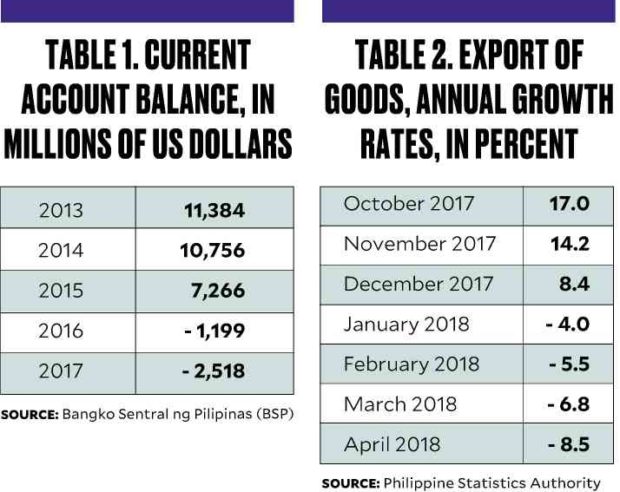Where will the peso go from here?
The exchange rate between the peso and the US dollar depends on the supply of dollars within the Philippine economy.
If there is a net inflow of dollars, each dollar becomes cheaper in peso terms, so the peso strengthens (say, P53 per dollar becomes P52).
If there is a net outflow of dollars, the peso weakens (P53 per dollar becomes P54).
Hence, it comes down to looking at the factors behind the inflow and outflow of dollars.
The greenback comes in mainly via the export of goods, the export of services like business process outsourcing (BPO) and tourism, remittances from abroad, investments.
The dollar flows out chiefly via the import of goods.
Article continues after this advertisementInflow versus outflow
Article continues after this advertisementA useful indicator is the current account, which contains all exports minus all imports, plus net income from abroad (e.g. from OFW remittances) and a few smaller components. The current account balance has been dropping. (See Table 1)
The Bangko Sentral ng Pilipinas reported in mid-June that the current account would end in a deficit of $3.1 billion by the close of 2018. That’s four times the earlier estimate of $700 billion.
The BSP says this is mainly because “growth in goods imports largely outpaces exports growth.” This import trend is seen to “gain further traction in 2018.” In fact, BSP raised its projection for imports growth to 11 percent, up from the earlier estimate of 10 percent.
Surging imports
Imports tend to exceed exports and the gap has been growing since 2015.
This is partly caused by the economy’s growth—the country has to buy more oil and machinery from abroad.
The recent surge in imports is also due to the government’s “Build, Build, Build” infrastructure program. By April 2018, imports of capital goods (e.g. machines for construction and manufacturing) rose by 29 percent compared to the year before.
In contrast, the export of goods has not kept pace with the imports. In fact, export growth rates have been falling, even turning negative lately. (See table 2)
Exports here are highly dependent on imports, i.e. they have low value-added. And while manufacturing is rising, it is not yet at the level shown by Vietnam, Indonesia and Thailand.
Moderating BPO revenue
The growth in OFW remittances has also been slowing down in recent years. It was 7.2 percent in 2011, and it is now down to 3.5 percent in January-April 2018. Economic troubles in Kuwait, the United Arab Emirates, Qatar, and Saudi Arabia contributed to the sluggishness in OFW money.
The BPO sector remains an economic driver, but the growth rates are receding to more normal rates. Annual growth was at 17 percent in the past six years. However, the Information Technology and Business Process Association of the Philippines (IBPAP) now forecasts it at just 9 percent per year until 2022. (Then there is the threat of automation to BPO.)
What about tourism as a major dollar earner? This will be difficult given the closure of Boracay, the rising number of killings, and the healing of war wounds down south.
There is also a dollar outflow from Filipino investments abroad. For example, Jollibee will open more than 130 new stores abroad in 2018, while Manila Water will expand in Vietnam, Thailand, Burma, and Indonesia. This trend will likely continue for big Filipino firms.
Rate hikes abroad
For the next few years, the peso will face rising global interest rates. After the 2008-2009 Great Recession, the US Federal Reserve (the Fed or their central bank) drastically lowered interest rates and maintained this easy money for years. However, the Fed is now reversing course amid faster economic growth.
Hence the Fed pulled up interest rates in mid-June, the second time in 2018. Its policymakers forecast two more rate hikes this year and three in 2019.
Rising US interest rates strengthen the US dollar, conversely weakening the peso in dollar terms.
With all these factors taken together, the country will likely see net US dollar outflows in the medium term.
Healthy economic growth and “Build, Build, Build” will lead to more imports until the end of the present administration. OFW remittances will post steady but slower growth. BPO industries will coast with moderate growth until 2022. Expectations for tourism are downsized. Big Filipino firms will continue to invest more dollars abroad.
Add to these the fact that the United States is set for more interest rate hikes.
All told, these factors will continue to weaken the peso until at least 2022. Business should take advantage of this by going into exports, particularly those less dependent on imports, like labor-intensive industries.—CONTRIBUTED
